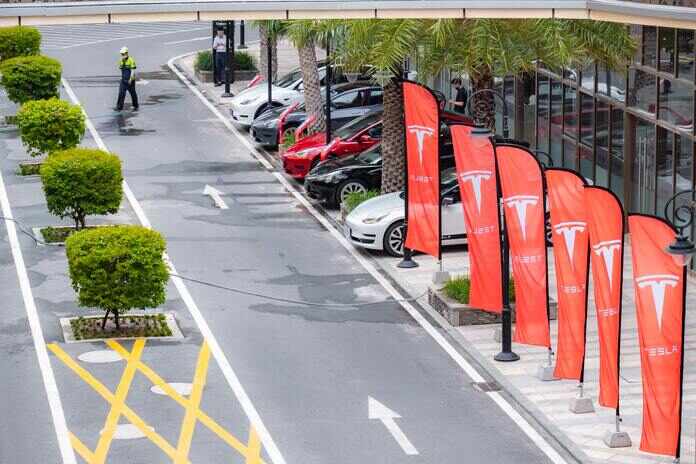Tesla Stock (NASDAQ:TSLA)
On Monday, Tesla Stock (NASDAQ:TSLA) achieved a record 12th consecutive session rise, which was boosted by optimism regarding the company’s charging network, the Cybertruck, and potential tax credits. Both worries about its security and calls for lower prices failed to derail it.
Tesla stock has recently accomplished a remarkable feat by hitting a record-breaking 12th consecutive session rise. This achievement is a testament to the company’s relentless pursuit of innovation and disruptive technologies. With each passing session, Tesla’s stock defies market expectations and continues its upward trajectory, capturing the imagination of both investors and enthusiasts alike.
The stock ended the day with a gain of 2.2%, trading at $249.83. Since the market closed at $182.90 on May 24, which was the most recent day that prices went lower for the shares, it has increased in value by almost 37%. On Monday, the S&P 500 index and the Nasdaq composite both experienced gains of 0.9% and 1.5%, respectively.
A few factors have contributed to the rise in share price. The full $7,500 federal tax credit can now be claimed on the purchase of any version of the Model 3, making the vehicle more affordable for a wider range of customers. Before the Internal Revenue Service updated the requirements for eligibility, the standard-range trim was only eligible for a credit of $3,750.
Following the example set by Ford Motor (NYSE:F), Tesla has reached an agreement to allow electric vehicle (EV) owners from General Motors (NYSE:GM) to use its supercharger network. This will result in additional revenue for Tesla as well as make its network the de facto standard for use in the United States.
Electrek reported that Tesla was planning to produce approximately 375,000 Cybertrucks each year, which boosted investor sentiment and expectations regarding Cybertruck sales volumes. According to Wall Street’s projections, annual sales of no more than 250,000 trucks should be expected. A request for Tesla to comment on its production plans was met with silence from the company.
On the other hand, price reductions and ongoing safety investigations could have a negative impact on investor sentiment. NIO (NIO), a Chinese manufacturer of electric vehicles, reduced the prices of its entry-level models by approximately $4,500, or approximately 10%, over the course of the weekend.
Tesla began 2023 by aggressively lowering prices in China and throughout the rest of the world. As a result, Tesla gained market share in China and throughout the rest of the world in the first quarter. Price cuts implemented by competitors might put that in jeopardy.
According to an article published by The Washington Post on Saturday, the number of accidents that may have been caused by Tesla’s autopilot driver-assistance system is significantly higher than what was previously reported. On Monday, investors were faced with the challenge of processing this information.
According to the Post, there are approximately one hundred incidents involving Autopilot occurring every three months. Tesla didn’t respond to a request for comment.
Undoubtedly, Tesla has a greater number of incidents than other car manufacturers, but one possible explanation is that Tesla automobiles communicate marginally better than other brands. Car telematics are responsible for reporting approximately 70% of all accidents. When the car reports an incident to Tesla, the company has a responsibility to inform the National Highway Traffic Safety Administration of what took place. Customers report approximately twenty percent of all incidents.
Autopilot is the name given to the fundamental version of Tesla’s driver-assistance software, which is able to perform tasks such as regulating speed and maintaining a vehicle’s position in the center of its lane. The majority of new cars come equipped with systems that are very similar to one another. The system that Volvo uses is called Pilot Assist, and Ford’s system is called Blue Cruise. Upgrades known as “advanced autopilot” and “full-self driving capability” are available for purchase from Tesla at an additional cost.
All three of these Tesla products are what are known as level 2 systems, which means that drivers are required to pay full attention to the road at all times. This requirement is shared by almost all other driver assistance technologies currently in use on roads in the United States. The vehicles are not capable of truly driving themselves.
Since 2021, the NHTSA has been conducting an investigation into Tesla Autopilot. If the NHTSA finds that there is a problem with the product’s level of safety, an investigation, which is the normal step that occurs after the agency has received and evaluated complaints, can almost immediately become a recall. In the worst-case scenario, a recall of Autopilot could result in a software update that modifies the product, or Tesla could choose to turn off the feature entirely.
The National Highway Traffic Safety Administration (NHTSA) is the source of many documents relating to the investigation and the complaints
Products that assist drivers, such as Autopilot, are developed with the goal of making driving more secure. Tesla publishes safety reports on a quarterly basis, providing details and statistics on the driver assistance features it maintains. They give off a powerful impression. According to Tesla, Tesla drivers travel four to five million miles before being involved in a significant accident, which is significantly better than the average for all drivers in the United States.
However, there is not enough context provided for the Tesla statistics to allow for a direct comparison with the overall highway safety statistics. For instance, if the majority of people use autopilot on interstate highways, then the safety statistics for autopilot need to be compared with the safety numbers for interstate highways rather than just the national average.
Already, a recall has been issued as a result of the investigation into Autopilot. In February, Tesla released a new version of its FSD product along with an over-the-air software update.
Accidents on American roads are responsible for the deaths of approximately 40,000 people each year.
Any manufacturer of automobiles would be wise to keep a close eye on safety concerns at all times. And despite the fact that every stock has both positives and negatives, investors are currently concentrating their attention on Tesla’s positives.
Featured Image: Pexels















